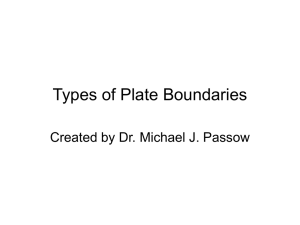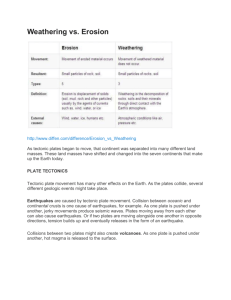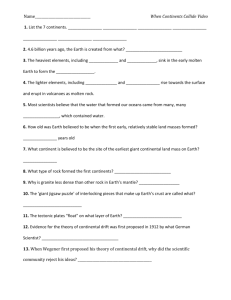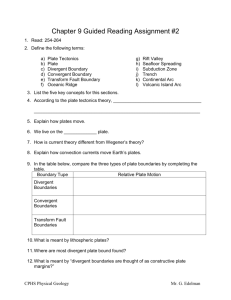Key for study guide
advertisement
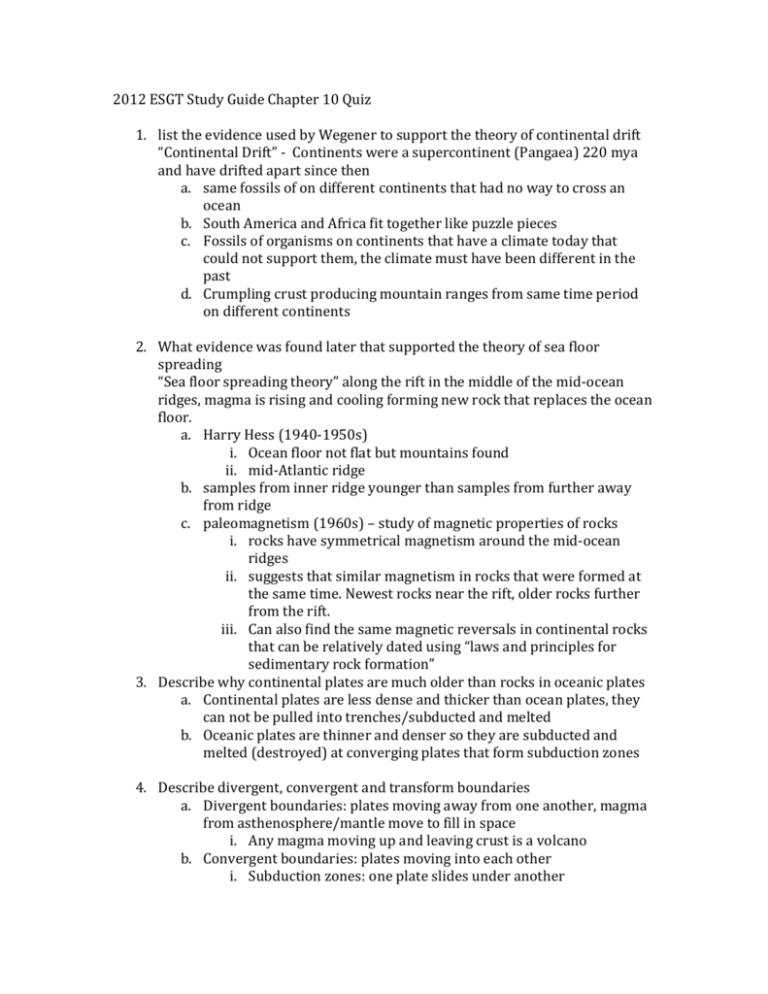
2012 ESGT Study Guide Chapter 10 Quiz 1. list the evidence used by Wegener to support the theory of continental drift “Continental Drift” - Continents were a supercontinent (Pangaea) 220 mya and have drifted apart since then a. same fossils of on different continents that had no way to cross an ocean b. South America and Africa fit together like puzzle pieces c. Fossils of organisms on continents that have a climate today that could not support them, the climate must have been different in the past d. Crumpling crust producing mountain ranges from same time period on different continents 2. What evidence was found later that supported the theory of sea floor spreading “Sea floor spreading theory” along the rift in the middle of the mid-ocean ridges, magma is rising and cooling forming new rock that replaces the ocean floor. a. Harry Hess (1940-1950s) i. Ocean floor not flat but mountains found ii. mid-Atlantic ridge b. samples from inner ridge younger than samples from further away from ridge c. paleomagnetism (1960s) – study of magnetic properties of rocks i. rocks have symmetrical magnetism around the mid-ocean ridges ii. suggests that similar magnetism in rocks that were formed at the same time. Newest rocks near the rift, older rocks further from the rift. iii. Can also find the same magnetic reversals in continental rocks that can be relatively dated using “laws and principles for sedimentary rock formation” 3. Describe why continental plates are much older than rocks in oceanic plates a. Continental plates are less dense and thicker than ocean plates, they can not be pulled into trenches/subducted and melted b. Oceanic plates are thinner and denser so they are subducted and melted (destroyed) at converging plates that form subduction zones 4. Describe divergent, convergent and transform boundaries a. Divergent boundaries: plates moving away from one another, magma from asthenosphere/mantle move to fill in space i. Any magma moving up and leaving crust is a volcano b. Convergent boundaries: plates moving into each other i. Subduction zones: one plate slides under another 5. 6. 7. 8. 9. 1. Super heating of rock that leads to volcanoes at this boundary ii. Collision zones: to plates collide (usually continental plates) and land is “pushed up” into mountains c. Transform boundaries: plates slide against each other going in different directions. Rubbing of plates causes pressure and friction (Earthquakes) What geological events/formations do you expect to see at the different boundaries? a. Divergent boundaries: mid-ocean ridges, volcanoes, rift zones, b. Convergent boundaries (subduction zones): volcanoes, island archs, trenches, earthquakes c. Convergent boundaries (collision zones): mountains, earthquakes, faults d. Transform boundaries: faults, earthquakes i. Some short sections of mid-ocean ridges are transform boundaries and have Earthquakes Why are volcanoes found at divergent and convergent plate boundaries? a. Divergent boundaries: magma rises because of empty space (moves toward area of least pressure) b. Convergent boundaries: superheated rock (friction and pressure) at subduction zones is less dense and will move through cracks in continental plate to the surface (area of least pressure) Explain the 3 causes of plate movement described in your textbook. a. Convection currents of mantle: hotter rock is less dense than cooler rock, over time hot rock rises displacing cooler rock that moves downward. Over 100,000 thousands of years a covection cell is completed as rock moves from upper part of mantle to lower mantle and back again. b. Ridge push: newest oceanic rock is least dense (warm) and rises above older oceanic rock. As it ages and cools it becomes more dense and sinks downward. This puts downward pressure on rock and the asthenosphere under it. As asthenosphere deforms because of pressure it moves….taking plate above with it. c. Slab pull : as oceanic plate moves under continental plate (subduction zone) it starts to move quicker, pulling the rest of the plate toward the subduction zone. Describe 2 ways that continents get smaller, describe 2 ways that continents grow. a. Continents get smaller by erosion and by continental rifting (breaking) b. Continents grow by addition of rock through volcanic activity (magma/lava). Think of the Hawaiian Islands growing i. or by different terranes colliding and becoming part of a continent (accretion) What is the main cause of changes in life once continents are separated? a. Change in organisms to adapt to their new environments by natural selection. 10. What plate are we on? What is its rate and direction of movement? What geological events/formations do you expect to see and where in North America? a. North American Plate b. Moves southwest away from mid-Atlantic ridge, rate about 1cm/year c. Maryland is in the middle of the plate so you don’t expect much to happen d. faults (Earthquakes) along transform boundary in California and off coast of entire west coast of North America e. 11. Be able to calculate distance, time or rate of plate movement if you are given two of the variables. Rate = Distance/time time = Distance/rate Distance = Rate X time
